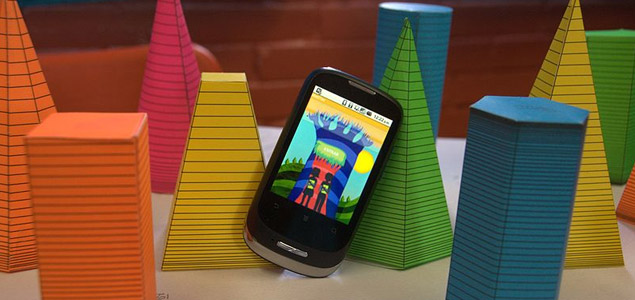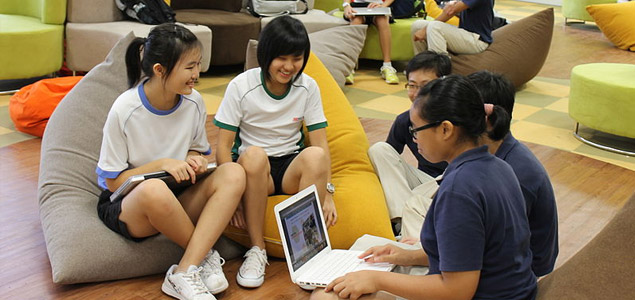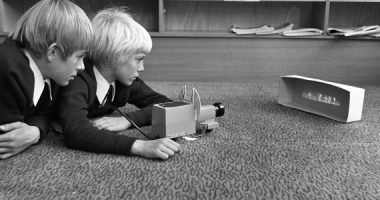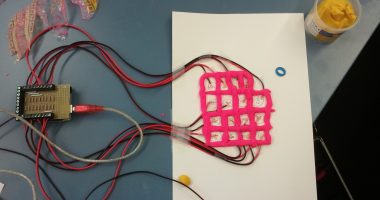
Mechanical calculating machine by George B. Grant Co. Illustration published in Scientific American, May 1877. Source: Wikipedia.
Education experts warn that we have an anachronistic educational system, created 300 years ago to meet the needs of a period that revolved around the industrial production of objects. They advocate the need for a new educational approach based on the generation of ideas, creativity and emotions, with the capacity to prepare children for the challenges of a world in which unlimited access to information has changed the way we communicate, process information, and think. Technology must play an important role in this new model, so as to stimulate learning and transform it into a more enriching, participatory and engaging process.
The idea of using the Internet in his classes had not crossed Jon Beasley-Murray’s mind until that moment. As a lecturer in Latin American literature at the University of British Columbia in Canada, he had not thought of Wikipedia as anything other than a poor source of documentation for his students. But in 2008, after being struck by his students’ passion for the Net, he decided to try a different strategy and carry out an experiment.
He asked his students to create entries on a series of South American novelists whose online presence was slight or non-existent. The challenge was to create high-quality content, because if their articles were given ‘good article’ status by Wikipedia they would automatically get an A for the course, and if an article was ‘featured’ – at that time there were only 2000 featured articles in English– they would get an A+.
The students split up into teams, started to gather information, and acquired all the traditional research skills (reading, documentation, referencing, writing and critical learning) in the process. Three of the teams wrote pieces that were classified as ‘good articles’ by Wikipedia, and one –the entry on the novel El Señor Presidente– was featured. At the end of the academic year, the students were thrilled. They had not only completed an interesting project, they had also made it ‘real’: through their work they had contributed to global knowledge, and their efforts had been recognised by thousands of Internet users.
This Canadian teacher’s initiative is an example of the new wave of educators who believe that new technologies, used wisely, can stimulate learning and transform it into a more enriching and participatory process. It is an approach that has been clear for a long time now in countries such as Finland, for example, which has the world’s best education system according to the latest PISA report. Students in this Scandinavian country are taught how to think, rather than memorise, and this entails studying subjects that students are interested in as well as using educational tools that motivate them, namely new technologies.
Students in Finnish classrooms watch videos on YouTube, use Wikipedia to research their projects, read digital comics, listen to music, and create playlists for assignments that can include designing a soundtrack to express the feelings of Silvius, the heartsick character in Shakespeare’s As You Like It, for example. The idea is to find a hook that engages the kids, and then actively involve them in the learning process.

Programmed device for the study of mathematics as part of the program MatiTec de ITESM Campus Ciudad de Mexico. Source: Wikipedia.
But we can also find similar initiatives closer to home. There are already teachers in Catalonia and Spain who use augmented reality to show their students what a volcano is, or what a tyrannosaurus looked like; others programme small robots, create video documentaries about different types of energy and post them online, or get students involved in collective transmedia poetry projects. Other projects include Espiral in Catalonia, Novadors association in Valencia, and Aulablog, run by teachers all over Spain. The techno revolution seems to be well and truly underway in schools, and is starting to change the way we teach and learn.
“The existing educational system needs to be changed from top to bottom. It is totally anachronistic and obsolete, and it bores kids,” says Marc Prenksy, the education expert and provocateur who came up with the concept of ‘digital natives’ in 2001 and unleashed a worldwide debate on education. Meanwhile, Sir Ken Robinson, one of the leading international experts in this area and the protagonist of the most-watched TED Talk, argues that our schools were designed during the industrial revolution in order to train factory workers, people who could do the same thing repeatedly for many hours in a row. Schools followed the same pattern: all the children memorised and repeated certain information over and over again.
“But now we need to educate individuals who are able to face the unknown, who can deal with unexpected situations, come up with new ideas to problems that are changing all the time. Acquiring digital literacy will allow children to become more open-minded and creative, and prepare them to deal with the challenges of an uncertain future,” says Sergi Jordà, a lecturer at Universitat Pompeu Fabra.
From the production of objects to ideas
There have been more discoveries in the last fifty years than in the entire history of humanity. We have made the transition from an industrial society organised around the production of objects to an information society in which the raw material and the driving force are ideas, creativity, passion, and the ability to invent new jobs that are more in tune with the era that we are living in. Moreover, scientific advances have allowed us to learn more about how our brains work. As the neuroscientist Francisco Mora explains in his book Neuroeducación. Sólo se puede aprender aquello que se ama (“Neuroeducation. We only learn by doing what we love”), we don’t learn by memorising or repeating things, but by doing, experimenting, and, above all, by means of emotional engagement.
Neuroscience has shown that attention plays a key role when it comes to learning. “It’s like a window that opens into the brain, through which we learn and memorise information from the world around us,” Mora says. “Without attention there is no explicit memory or knowledge.” And one way to capture the attention of students is to use something they are passionate about –digital technologies–, excellent allies when it comes to stimulating curiosity and motivation, which are basic ingredients of learning.
Even so, simply introducing digital tools into the classroom is no guarantee in itself. As high school teacher Sandro Maccarrone explains, “new technologies can be used to continue to do exactly the same thing (that we have been doing for the past 4,000 years). Or to do it worse, because the information is presented in a less focused way.” As such, we need a solid educational project that goes hand in hand with methodological change, in which instead of simply transmitting information to students, teachers become their guides, helping them to ask the right questions, stimulate their curiosity, accompany them as they look for the information they need, and teach them to work in teams: skills that they will need throughout their adult lives.
Technology in the classroom
But what are the advantages of using digital tools in the classroom? Aside from the appeal of digital blackboards or augmented reality, which attract students’ attention, most experts emphasise that one of the key points of new technologies in the classroom is that they make it possible to customise education, so that each child can follow his or her own process and be given tools that support autonomous learning, experimentation and research.
Another important element is an Internet connection, because it provides students with a window into the world, and much more information than they could ever get from their teachers or textbooks. Nonetheless, teachers still need to develop the critical faculties of students, teach them to distinguish between important information and simple noise.
Many digital tools promote teamwork, collaboration and interaction, and as such they strengthen students’ empathy and emotional skills, which are essential for relating with others. And they also stimulate the students’ creativity. Jordi Adell, a teacher in the education and school organisation section of the Department of Education at James I University in Castellón de la Plan, and director of its Centre d’Educació i Noves Tecnologies (CENT), draws attention to the fact that kids have mobile phones in their pockets that incorporate a video camera, still camera, voice recorder, Internet connection, and GPS. A huge number of educational activities can be carried out with mobile phones: “the truly revolutionary thing is to put technology in the hands of the kids so that they can create, construct and learn.”
“Students don’t learn from teachers or from technology. They learn from thinking about what they are doing, they learn from what they have done, from the processes. Thinking promotes learning,” adds Jennifer Groff, a researcher at the Massachusetts Institute of Technology (MIT) Media Lab.

Students of School of Science and Technology, Singapore. Source: Wikipedia.
Some people take the idea even further and claim that technology even allows children to learn on their own. In the late 1990s, Sugata Mitra, a teacher of education technology at the University of Newcastle in the United Kingdom, began to carry out a series of experiments in which he left computers in very poor shanty towns in India without giving the inhabitants any kind of explanation, and returned a few months later. The results were always the same: the village kids had learnt to use the computer on their own, without instructions; the kids taught each other, and even managed to learn about complicated things like molecular biology in English, a language that was unfamiliar to them.
“If we are curious enough, we can learn by ourselves,” he says. This year, the TED Prize awarded him a million dollar grant to continue this project. Another initiative based on a similar philosophy is the massive open online courses or MOOCs that emerged on the net a few years ago. These courses, which may be free or require students to pay an enrolment fee, are offered online by universities along with educational material, recorded lectures, bibliographies and podcasts so that students can follow them and interact with fellow students all over the world. This increases access to knowledge and democratises it, so that it may end up reaching the most disadvantaged corners of the globe.
The dark side of technology
But not all education experts have such a positive view of the use of digital tools in the classroom. Many of them warn of the dangers of multitasking while children learn, for example. Some studies claim that if students’ attention is divided amongst a range of information and entertainment sources as they study, do homework or sit in class, they learn more superficially, understand and remember less, and have more difficulties when it comes to applying what they have learnt to new concepts. David Meyer, professor of psychology at the University of Michigan, warns that it appears that activities such as sending whatsapps or updating Facebook require as much mental engagement as school does. “Multitasking has very high cognitive costs,” he says.
Other studies warn that digital technology has a negative impact on the behaviour of children. They say it tends to make them antisocial, prevents them from concentrating in class, and distracts them. And some teachers fear that students will get used to the copy-paste mentality and the Wikipedia philosophy of finding answers quickly and easily. And that they will become used to the overly colloquial language used on social media and be unable to change to a more formal register in their schoolwork.
“There is a lot of confusion right now,” says Lali Bosch, professor of philosophy and a member of the core research group at the Innovation and Research on Teaching Philosophy Group. “New technologies have great potential in terms of knowledge, but there is also a problem: Karl Marx showed us that transferring the qualities of people onto things creates a situation of fetishism, and digital screens can lead us into this spiral. Knowledge, which arises in response to curiosity, must be at the heart of education. Therefore, anything that arouses curiosity is welcome.”
Technology is present in all areas of our life, and just as we wouldn’t consider it reasonable to tell banks, hospitals or industry to go easy on technology, most kids don’t find it reasonable for schools to ban them from using it. They see the Internet, for example, as essential for interacting with their friends, for having fun, and for learning too.
“We need to teach children digital literacy, to teach them reading and writing, but also the language of machines given that understanding how programming works and having basic skills will be the Latin of the 21st century,” argues Sergi Jordà from UPF, “if we want them to become adults who understand what is happening in the society they live in and to have greater control over their lives.” These days, Wikileaks, Anonymous, and anything that entails some resistance to global trends involves fluency in these tools. If we teach children digital literacy, we will have freer citizens.”






Jordi Benet | 24 December 2013
Fa anys que sóc defensor de l’utilització de les noves tecnologies a l’aula. Els professors no podem restar aliens a la realitat que viuen els nostres alumnes. De totes maneres també crec que cal ser conscients dels límits de tot plegat. Les noves tecnologies han de ser una eina que ajudi els alumnes en el seu aprenentage però mai poden acabar sent el motiu central d’una activitat. M’explico… Apareixen noves eines contínuament però no cal utilitzar-les totes. No totes les eines són adequades per a la nostra classe i de vegades ens trobem amb activitats en que semblen respondre més que a una necessitat pedagògica real a la voluntat de deixar constància que coneixem aquelles eines.
Qualsevol eina d’allò que anomenem noves tecnologies serà útil per les nostres classes si ens ajuda a que els nostres alumnes pensin més i millor. @jbenet
Sistema educativo | Pearltrees | 13 November 2016
[…] Los autores del estudio, F. 100 Consejos prácticos para ser un buen docente. Tecnorevolució a les aules | CCCB LAB. […]
BIBLIOGRAFÍA – EVA Enseñanza y aprendizaje de una Lengua Extranjera. Subgrupo 10 | 26 March 2022
[…] Sáez, C. (2013) Tecnorrevolución en las Aulas. Recuperado el 23/3/2022 de CCLAB:Tecnorrevolución en las aulas | CCCB LAB […]
Leave a comment